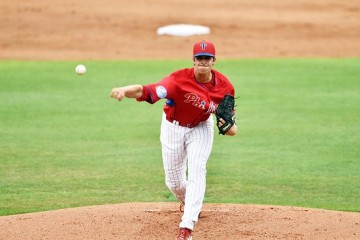2014 MLB Draft: The Pitchers
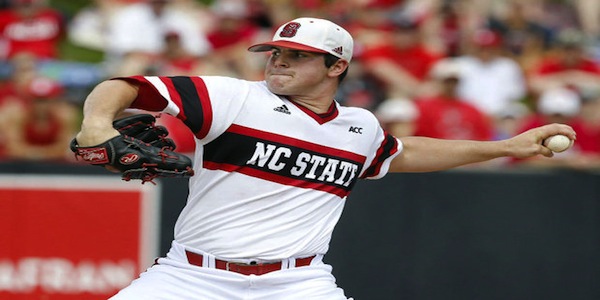
After the appetizer, it’s time for the main course. What the 2014 MLB Draft lacks in hitting talent it makes up for in intriguing arms. Here are the ones with the best chances of being first round picks come June 5th.
Carlos Rodon – North Carolina State University, LHP
Rodon entered the spring as the presumptive number one pick and while he’s been a little bit up-and-down for NC State concerns are overblown . Rodon will go into the draft with 117 K in 98.2 IP against 31 BB. That kind of season can only be “disappointing” for a player the quality of Carlos Rodon.
Rodon set strikeout records as a sophomore thanks to mid-90’s heat and a truly dominating slider. A physically mature build, 6-foot-3, 235 pound southpaw, Rodon’s pitching mechanics are a study in the economy of power. He may have been a bit over worked this spring, Rodon leads the world in 130+ pitch games, but he should hold elite left-handed velocity deep in games as a pro. Rodon’s command isn’t great, but it isn’t an issue either.
Perfect World: A mini-Randy Johnson. Electric stuff, huge K totals, a true ace who makes many an opposing left-handed hitter to suddenly develop a sore muscle on days he’s scheduled to pitch.
More Likely: Not too far from that. I’m a Rodon believer; placing more emphasis on the total body of work than a few slightly less than stellar outings. Rodon should move quickly through the minor leagues and front a staff in just a few years. The pure stuff and total body of work don’t come along that often.
Brady Aiken – Cathedral Catholic HS (CA), LHP
The only player on the board I could see taking over Rodon, Brady Aiken projects to do virtually everything well as a professional. His fastball has gained velocity to the point where it’s now easily plus while keeping elite movement. Aiken’s curve-ball is terrific and his command could be even better.
He’s a super athletic, potential workhorse with elite command of front-of-the-rotation stuff. I could go on and on about Aiken, but I’ve already done that.
Perfect World: Clayton Kershaw, with more natural sink on his fastball.
More Likely: A really terrific, front-line starter who induces tons of weak contact and ground balls, never walks anyone and gets more than his fair share of K’s.
Tyler Kolek – Shepherd HS (TX), RHP
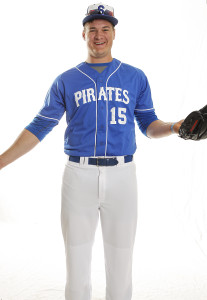 The strongest, most powerful high school arm, likely, of all-time. Earlier this spring Kolek hit 100+ MPH on six consecutive pitches, topping out at 102 MPH. Kolek compliments his top-of-the-scale fastball with two terrific breaking balls. His slider and curve-ball both project to be possible plus pitches.
The strongest, most powerful high school arm, likely, of all-time. Earlier this spring Kolek hit 100+ MPH on six consecutive pitches, topping out at 102 MPH. Kolek compliments his top-of-the-scale fastball with two terrific breaking balls. His slider and curve-ball both project to be possible plus pitches.
At 6-foot-5, 230 pounds Kolek has long levers in his delivery and is still growing into his body and doesn’t repeat his mechanics as well as you might hope. He throws across his body and has below-average command right now. Kolek’s extreme velocity and iffy mechanics put him at an increased risk of injury but there is risk inherent in everything.
Perfect World: The most dominating pitcher on earth; perennial league leader in K’s, broken bats and shattered dreams.
More Likely: If you know what is likely for Tyler Kolek every team in baseball is waiting to give you a job. I’ll split the difference and say an occasionally great, occasionally injured sort of wild starting pitcher. Maybe A.J. Burnett 2.0.
Aaron Nola – LSU, RHP
One of the college baseball’s most dominant pitchers, Nola feature’s above-average stuff and command which should allow him to help a big league club as soon as any starter in the draft. Nola has been nigh unhittable for most of his time in Baton Rouge (why Nola didn’t decide to go to school in New Orleans is beyond me) thanks to a 90-93 MPH fastball with outstanding movement, and both an above-average breaking ball and change-up. Nola’s knowledge of pitching and how to set-up hitters is unrivaled in the college ranks. While he may not ever be much better than he is right now, Nola is basically a big league caliber pitcher today.
Nola attacks hitters from an unconventional and potentially worrisome motion. Nola uses a very low-3/4 arm slot, bordering on a true-side arm motion, and is something very few starters manage long-term. Nola’s a short strider who doesn’t generate much force with his lower-half, leaving his arm to do most of the work.
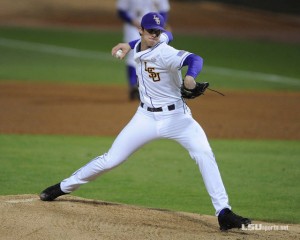
A lot of work remains to be done on pitching mechanics but a few things appear clear in terms of injury prevention and the big one is timing. Ideally, a pitcher wants to have the ball up in a position ready to be accelerated towards home-plate when his stride foot makes makes contact with the ground and his shoulders begin to open. Healthy pitching mechanics are about building a kinetic chain; timing is the links in the chain. Nola is still in the “pick-up” phase of his delivery at foot-plant, meaning his arm has to “catch-up” to the rest of his body.
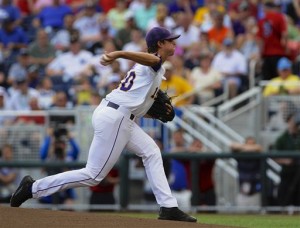 Another key moment is “maximum external rotation” i.e. the moment when the forearm lays back just before accelerating the ball towards home. Like a fully loaded catapult, there are a lot of stresses going on inside the arm at this point and even in the most efficient pitching motions tendons inside the arm are brought very close to their breaking-points. The degree to which the forearm is flexed is a decent, though imperfect, proxy for force loads inside the arm; Nola experiences a VERY HIGH degree of maximum external rotation.
Another key moment is “maximum external rotation” i.e. the moment when the forearm lays back just before accelerating the ball towards home. Like a fully loaded catapult, there are a lot of stresses going on inside the arm at this point and even in the most efficient pitching motions tendons inside the arm are brought very close to their breaking-points. The degree to which the forearm is flexed is a decent, though imperfect, proxy for force loads inside the arm; Nola experiences a VERY HIGH degree of maximum external rotation.
Perfect World: Nola secretly had his insides replaced with adamantium and develops into a terrific No. 3 starter, borderline No. 2 guy who is among the league leaders in WHIP.
More Likely: Nola gives teams a few good years as a league-average starter but injuries plague his career.
Kyle Freeland – Evansville, LHP
This spring Kyle Freeland has allowed fewer walks and extra base hits (both 13) than he’s had starts (14). He’s struck out 128 batters in just under a hundred innings, that’s a 10.67:1 K:BB. The next closest college pitcher who struck out at least a batter an inning is at 6.4:1 (Rice sophomore closer Matt Ditman).
Freeland has dominated the Missouri Valley Conference with big league stuff. His fastball has gone from the mid-80s as a freshman to 90-93 MPH, touching higher. Freeland makes ample use of both a two and four-seam fastball, his slider also comes in at a couple of different variations. Freeland uses a hard, cutter-like slider as an out pitch but also mixes in a slower, more curve-like slide piece occasionally to keep hitters off balance. Depending on how bullish you are about his change-up (I haven’t seen him enough to have a hard opinion one way or the other) Freeland could end up with a deep arsenal of above-average to plus big league stuff.
Perfect World: He adds another tick or two of velocity, the change develops into a 55-grade pitch and Freeland has a terrific career as a quality No. 2 starter.
More Likely: His fastballs and hard slider are enough to get people out and Freeland is a reliable, quality No. 3 guy.
Jeff Hoffman – East Carolina State University, RHP
There was talk of Hoffman potentially going No. 1 overall before shoulder soreness then, Tommy John surgery ended his spring. That talk was crazy when Hoffman was healthy, at no point in his development has Hoffman been better than Rodon or Aiken but that is not saying Hoffman is without talent. One of the stronger arms in the draft, Hoffman has shown mid-90s velocity, flashed a plus curve-ball and has solid feel for a change-up.
In terms of pure potential and arm strength, Hoffman is one of the most intriguing players in the draft; intriguing in large part because 18 months ago, he was a completely different pitcher. Hoffman struck out under 7 batters per nine innings as both a freshman and a sophomore (6.7 and 6.9 K/9 to be exact). Hoffman showed a bump in velocity over the summer, reaching 95 MPH in the Cape Cod League and carried over his new found stuff to the spring.
Even though the success rate for Tommy John surgery is very high, it should not be taken as a given that Jeff Hoffman will show elite stuff after recovery. Hoffman doesn’t repeat his mechanics that well, showed below-average command at times this spring and is much more raw than most college hurlers. While Hoffman represents tantalizing pure upside, his short track record of success, lack of polish and present injury concerns should drop him out of the first round. That seems unlikely though, if the buzz surrounding his name has any truth some team could take a big gamble on Hoffman in the middle of the first round.
Perfect World: A borderline No. 1 guy with big strikeout totals.
More Likely: There’s such a huge range of possibilities for Hoffman’s career, it’s hard to say what’s “likely”. For a college guy, he’s a long-term project who will need seasoning even after he’s completely healthy. He’ll likely flash upside for a few years but I have a hard time seeing a long, productive starting carer for Hoffman.
Tyler Beede – Vanderbilt University, RHP
The twenty first overall pick of the 2011 draft by the Blue Jays, Beede has has been equally frustrating and tantalizing during his three years a Commodore. Still, Beede has some of the better stuff in the draft; his fastball touches 96 MPH and his curve-ball, change-up combo is solidly above-average.
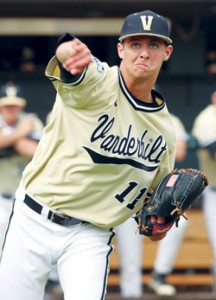 Beede’s biggest problem is poor command; he’s walked over 10% of hitters he’s faced this spring, and that represents a substantial upgrade over the 15+% he walked as a sophomore. Beede’s walk rate of around 4 batters per nine innings jumps to over 5 free passes a game if you add in the the 12 hit by pitches he’s surrendered this spring.
Beede’s biggest problem is poor command; he’s walked over 10% of hitters he’s faced this spring, and that represents a substantial upgrade over the 15+% he walked as a sophomore. Beede’s walk rate of around 4 batters per nine innings jumps to over 5 free passes a game if you add in the the 12 hit by pitches he’s surrendered this spring.
Beede’s up and down spring ended on an up-note as he dominated in the Regionals, striking out 14 across eight sterling innings. Occasionally it takes a while for pitchers to straighten out their control and Beede did show progress this year, unfortunately a lot of pitchers never figure it out and even with the progress Beede’s command is a huge red flag. On his best day Tyler Beede looks like one of the two or three best pitching prospects in college and top 10 talent, at his worst he looks like a guy who won’t make it past Double-A. Few players will be more divisive in draft rooms; some teams may have him near the top of the first round, others out of the first round entirely.
Perfect World: Beede turns into and effectively wild, workhorse starter with three well-above-average offerings
More Likely: Given where his command is presently and how far it has to go even plus arm strength and solid secondary offerings won’t be enough to turn Beede into more than a frustrating, back-end starter.
Grant Holmes – Conway HS (SC), RHP
A slightly undersized right-hander without much physical projection, Holmes is nonetheless one of the draft’s best, and most underrated, prospects. Holmes’ average (six-foot, 215 lb) stature hasn’t limited his velocity as he’s flashed upper-90’s and flirted with triple-digits this spring. Holmes combines elite arm strength with one of the better breaking balls in the high school class, a hard, tight 81-85 MPH curve-ball.
Holmes has shown some potential with a change-up but mostly in side-sessions as he’s had very little need to go to a third offering in games thanks to his elite two-pitch mix.
Holmes has a low-3/4 arm slot and there is a little bit of length in the back of his arm action but the ball jumps out of his hand free and easy.
Perfect World: The change-up comes along into a solid third offering ant Holmes rides a 70-fastball, 60-curve, 50-change and solid command to be one of the games better starters and helps the baseball industry overcome it’s long held and unfounded bias against short right-handed pitchers.
More Likely: The industry bias remains but Holmes’ ability lets him make a mark as an above-average pitcher; developing into a quality No. 3, possible No. 2 starter.
Sean Newcomb – University of Hartford, LHP
Not traditionally a baseball hotbed, Sean Newcomb should become the first Hartford Hawk drafted in the top 10 rounds of the draft since some tall, awkward infielder named Jeff Bagwell. Scouts braved frigid temperatures early this spring to see Newcomb flash mid-90’s velocity and four quality big league offerings.
Newcomb’s fastball sits 91-94 MPH with some arm-side run and, while he’s shown solid feel for both a curve-ball and a change-up, his slider has a chance to be a put-away pitch.
The biggest and most physically imposing of the high-end college pitchers in this year’s draft; the 6-foot-5, 240 pound Newcomb looks like he should be able to shoulder a heavy load in professional ball. His throwing motion is simple, his arm action is very short and smooth. Though his present command is below-average it should improve slightly if he can repeat his solid, efficient mechanics.
Perfect World: The cold-weather prospect sees a small bump in stuff and his command improves with experience eventually developing into a power lefty with a swing-and-miss slider who can give a team 200+ innings of No. 2 starter quality.
More Likely: Durable, four-pitch lefties with above-average stuff are always in demand. With slight improvement in command Newcomb turns into the new Matt Harrison, who, hopefully, never has to have his spine fused.
Touki Toussaint – Coral Springs Christian HS (FL), RHP
Touki Toussaint not only has one of the best names in the draft (though I’m still partial to South Carolina infielder Joey Pankake) he also has some of the highest upside. The slender 6-foot-2, 180 pounds, Touki Toussaint (you have to say the full name like with Ken Jennings or Bill Murray) unleashes occasionally electric stuff from a projectable frame.
His fastball sits 91-93 MPH but has touched as a high as 97 MPH and Touki Toussaint snaps off one of the wickedest curve-balls you’re likely to see from a high school pitcher. The potential for a dynamite fastball/curve-ball combo and an athletic, projectable frame have led to rumors of the Toronto Blue Jays being tied to Touki Toussaint with either the ninth or 11th draft pick.
Perfect World: Touki Toussaint uses two 70-grade offerings to develop into a front-line starter, borderline ace.
More Likely: Touki Toussaint, like all high school pitchers, carries an certain, inherent amount of risk but with even average player development and injury luck he should turn into a quality MLB pitcher. You’ll always take a chance on a loose, electric arm. That curve should get Touki Toussaint to the big leagues by itself.
Brandon Finnegan – TCU, LHP
Finnegan’s arm strength belies his small stature. The 5-foot-10, 175 pound (he’s listed slightly higher but I’ve stood next to Finnegan)
southpaw boasts a fastball that sits 91-94 MPH, flirting with higher velocities, an above-average slurvy breaking ball and a potentially average change-up.
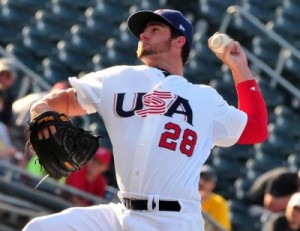 A few mechanical tweaks have spurred Finnegan to tremendous success his junior year. After slightly altering his stride and raising his arm angle just a bit, Finnegan posted a 122/25 K/BB in 91 sterling innings. Largely because of his size, and because of some experience his freshman year and on Team USA, Finnegan is sometimes projected as a future reliever but size matters much less than ability and stuff. Finnegan has more than enough stuff and ability to get hitters out multiple times through the order.
A few mechanical tweaks have spurred Finnegan to tremendous success his junior year. After slightly altering his stride and raising his arm angle just a bit, Finnegan posted a 122/25 K/BB in 91 sterling innings. Largely because of his size, and because of some experience his freshman year and on Team USA, Finnegan is sometimes projected as a future reliever but size matters much less than ability and stuff. Finnegan has more than enough stuff and ability to get hitters out multiple times through the order.
Perfect World: A 65-fastball, 60-curve, 55-change and 55-command make Finnegan a solid No. 2 starter and even an ace on some pitching staffs.
More Likely: Finnegan settles in as above-average pitcher, a high-end No. 3 starter.
Nick Burdi – University of Louisville, RHP
College baseball’s best closer gets the job done with an elite power arm. Burdi’s fastball regularly sits upper-90s and has touched triple digits. He compliments a borderline 80-grade heater with a tight, power slider which projects as a plus pitch. Burdi has solid command for someone who throws as hard has does and could go in the back half of the first round to a team looking for a quick return on investment. Only once all spring did Burdi surrender an extra base hit. His stuff is too good for most college age hitters to stand a chance. He should move quickly through the minor leagues.
Perfect World: One of the game’s elite closers, a potential top-5 guy at the position who overpowers hitters on route to 40+ saves a season.
More Likely: Still a good closer, relievers in general are a volatile mix but Burdi has a chance to be one of the few reliable arms in a good pen.
More pitchers than this will go in the first round but it’s hard to separate out the late first round to early second group that goes about a dozen players deep and rather than turn this into a 10,000 word column we’ll tackle those players as needed in post-draft wrap-ups.
My final draft board will up shortly.




